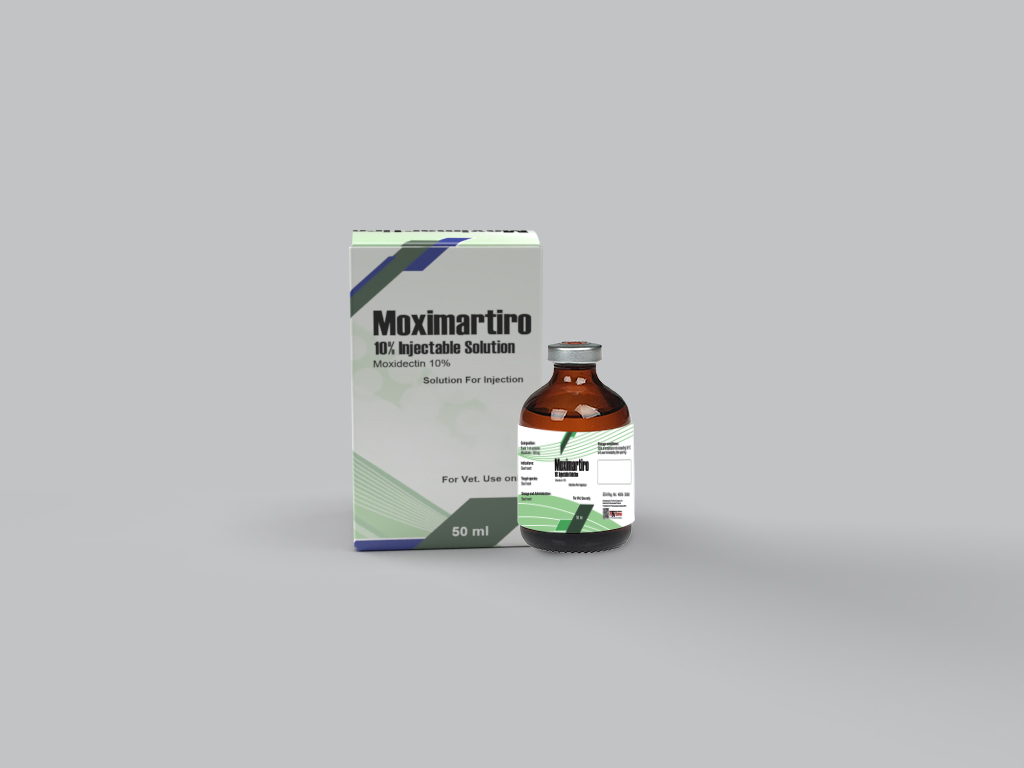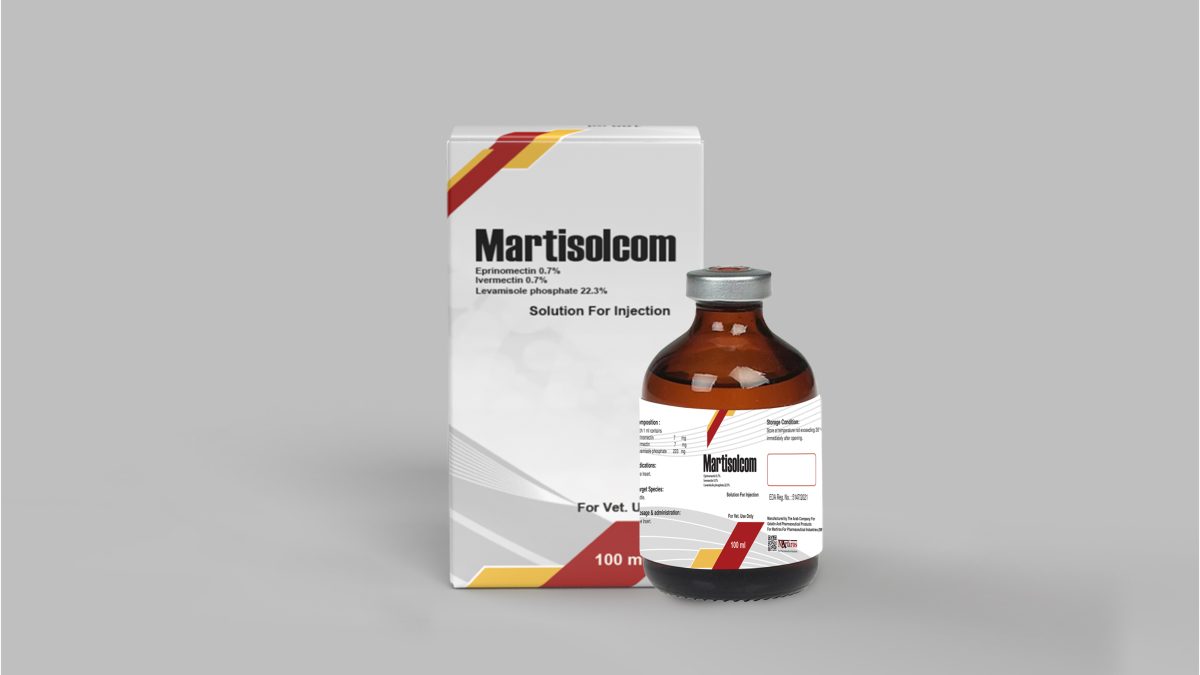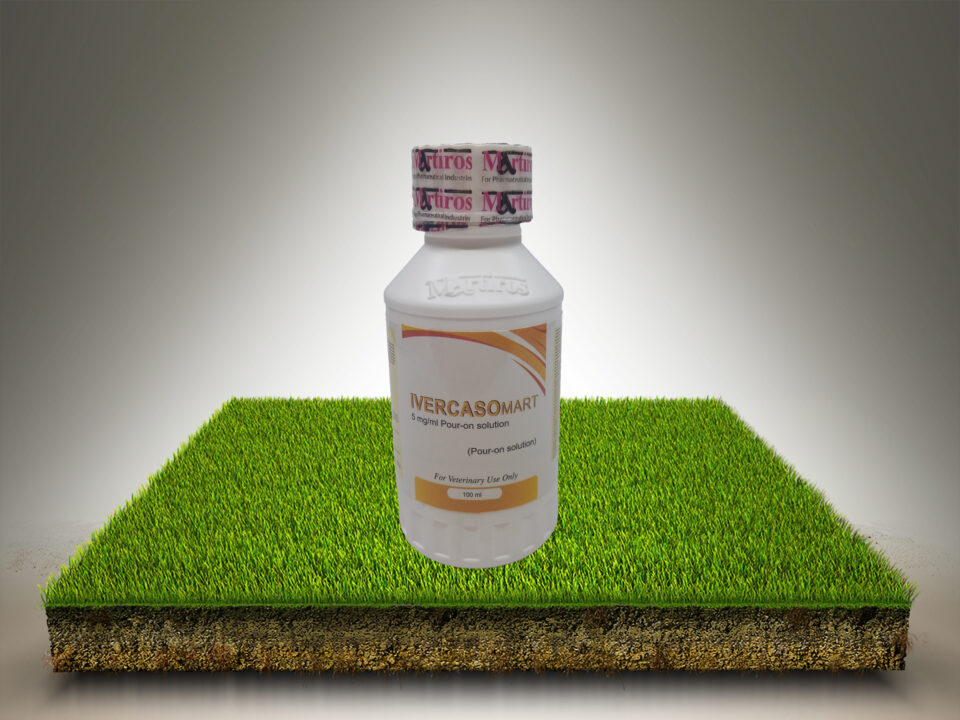
Martiroflox 16 %

Moximartiro 10 % inj
Solution For Injection
For Veterinary Use Only
Composition :
Each ml contains
Eprinomectin 7 mg
Ivermectin 7 mg
Levamisol phosphate 223 mg
Properties:
Eprinomectin binds selectively to glutamate-gated chloride ion channels which occur in invertebrate nerve and muscle cells. This leads to an increase in cell membrane permeability to chloride ions leading to paralysis and death of the parasite. Like ivermectin, eprinomectin also enhances the release of gamma amino butyric acid (GABA) at presynaptic neurons. GABA acts as
an inhibitory neurotransmitter and blocks the post-synaptic stimulation of the adjacent neuron in nematodes or the muscle fiber in arthropods. These compounds are generally not toxic to mammals as they do not have glutamate-gated chloride channels and these compounds do not readily cross the blood-brain barrier.
Ivermectin enhances the release of gamma amino butyric acid (GABA) at presynaptic neurons. GABA acts as an inhibitory neurotransmitter and blocks the post-synaptic stimulation of the adjacent neuron in nematodes or the muscle fiber in arthropods. By stimulating the release of GABA, ivermectin causes paralysis of the parasite and eventual death. As liver flukes and tapeworms do not use GABA as a peripheral nerve transmitter, ivermectin is ineffective against these parasites.
Levamisole stimulates the parasympathetic and sympathetic ganglia in susceptible worms. At higher levels, levamisole interferes with nematode carbohydrate metabolism by blocking fumarate reduction and succinate oxidation. The net effect is a paralyzing effect on the worm which is then expelled alive. Levamisole’s effects are considered to be nicotine-like in action. Levamisole’s mechanism of action for its immune stimulating effects are not well understood. It is believed it restores cell-mediated immune function in peripheral T-lymphocytes and stimulates phagocytosis by monocytes. Its immune stimulating effects appear to be more pronounced in animals that are immune-compromised.
Indications:
Gastro-intestinal roundworms : Adult and immature Small Brown Stomach Worm ( Ostertagia ostertagi , Ostertagia lyrata ) , Barber’s Pole Worm ( Haemonchus spp ), Stomach Hair Worm ( Trichostrongylus axei ), Black Scour Worm ( Trichostrongylus longispicularis ) adults only , Small Intestinal Worm ( Cooperia oncophora ,Cooperia punctata ) , Hookworm ( Bunostomum phlebotomum ), Large Bowel Worm ( Oesophagostomum radiatum ) adults only ,Thin-Necked Intestinal Worm ( Nematodirus helvetianus ) adults only , Whipworm ( Trichuris ) adults only .
Treatment and control of mature and immature strains of Cooperia spp resistant to endectocides . levamisole is also active against susceptible benzimidazole resistant strains
Lungworms : Adult and immature ( Dictyocaulus viviparous )
Sucking Lice : Linognathus vituli
Target Species:
Cattle.
Dose for active ingredient:
Administer as a subcutaneous injection in the anterior of the neck
Cattle : ( 0.2mg eprinomectin, 0.2mg ivermectin, 6.37 mg levamisole phosphate / kg body weight)
Dose for whole product:
Cattle : 1 ml per 35 kg body weight
Warnings:
- Symptoms of levamisole toxicity often mimic those of organophosphate toxicity. Symptoms may include hypersalivation, hyperesthesias and irritability, clonic seizures, CNS depression, dyspnea, defecation, urination, and collapse.
- Do not exceed the recommended dosage
Contra-indications
- Is contraindicated in lactating animals (not approved).
- It should be used cautiously, if at all, in animals that are severely debilitated, or have significant renal or hepatic impairment.
- Use cautiously or, preferably, delay use in cattle that are stressed due to vaccination, dehorning or castration
Side-Effects:
Adverse effects that may seen in cattle can include muzzle-foaming or hypersalivation, excitement or trembling, lip-licking and head shaking. These effects are generally noted with higher than recommended doses or if levamisole is used concomitantly with
organophosphates. Symptoms generally subside within 2 hours. When injecting into cattle,swelling may occur at the injection site. This will usually abate in 7-14 days, but may be objectionable in animals that are close to slaughter.
Withdrawal Periods:
21 days meat, 35 days milk
Storage conditions:
Store in dry dark and place at temperature not exceeding to 30 o.
Packaging:
Vial of 50,100 and 250 ml




